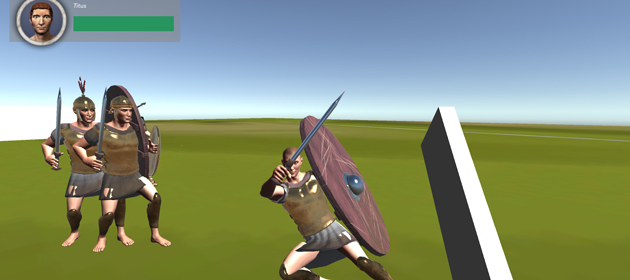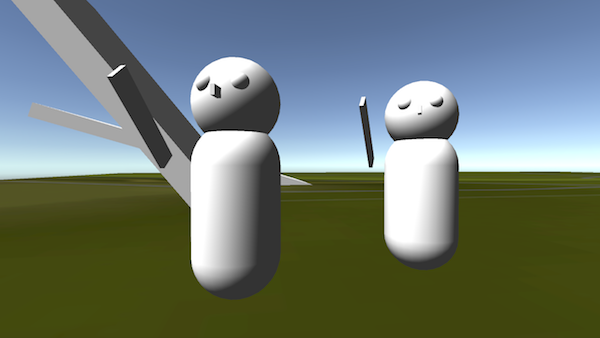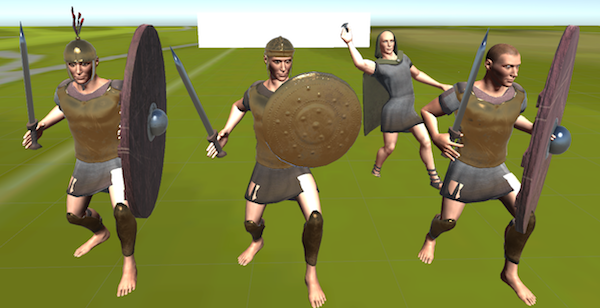
In my last post I talked about the new combat system for our game about Roman history, Saeculum. However, I left out one of the most important pieces to the puzzle: the player’s entourage.
As I discussed last time, the concept of an entourage was an extremely important learning goal, so we made sure to include it at the heart of our combat design. Over the course of the game, the player will be able to acquire clients that can be sent on various missions, such as conducting a business deal on behalf of the player or spreading political graffiti to improve the player’s image. Another use for clients is assigning them to the player’s entourage, where they will follow the player for that episode of the game. This grants many benefits, such as aiding in navigation tasks or helping the player in gameplay encounters.
In combat specifically, the player’s entourage joins the fight as AI-controlled allies. They’re intelligent enough to analyze the battlefield and assess various threats. If too many enemies are attacking the player, a member of the entourage will try to get the attention of an enemy and redirect their attacks. Entourage members don’t do much damage, but they can survive many hits. Essentially, they act as distractions for the enemy, allowing the player to better control the action by reducing the number of immediate threats to the player. Having less attackers makes it easier for the player to take out enemies one by one.
[caption id="attachment_13553" align="aligncenter" width="600"] Prototype versions of the player’s entourage[/caption]
Prototype versions of the player’s entourage[/caption]
Controlling the battle, matching numbers with numbers, and eliciting the feel of chaotic street combat… That was the direction we were shooting for, and the entourage gameplay greatly contributes to it. Entourage members feel important at a mechanical level, which reinforces the learning goal we want to communicate.
Entourage also contributes to the player’s tactical and spatial mindset. While beefy, entourage members are not invincible and can be downed after receiving too much damage. The player can revive them, but they must spend a short amount of uninterrupted time channeling near them, leaving them vulnerable. By keeping an eye on the status and positions of various entourage members, the player must make decisions regarding who to help and when to do so. This allows the game space to be more fully explored by encouraging movement and emphasizing positioning.
What’s also nice about entourage is that it also addresses the goal of accessibility by scaling with player skill. Players that are having a difficult time with the gameplay sections of the game can include more clients in their entourage, making combat encounters easier to clear. However, due to opportunity cost, skilled players are also awarded for having less members in their entourage; a client that is not used in entourage can be sent on the other aforementioned missions to reward the player in various ways. In other words, players are encouraged to only bring as many entourage as they need to surmount the various encounters.
[caption id="attachment_13554" align="aligncenter" width="600"] Grunts in the front, ranger in the back![/caption]
Grunts in the front, ranger in the back![/caption]
But enough about allies! What about the types of enemies that the player will fight? Right now we have three broad classes of enemies:
- Grunt – As the most basic enemy type, grunts are designed to be somewhat common in encounters. Generally, they just run up to the player in groups and attack with various melee attacks. While simple, they give the less prevalent but more specialized enemy types (see below) something to play off of. For example, a vulnerable ranged enemy would be less interesting if there weren’t melee enemies like the grunt to distract the player. The grunt also comes in many variations to suit the needs of the encounter. Some are fast and weak, while others are slow and strong. There are also shielded varieties, with some having shields so large that the player must maneuver behind them to deal damage.
- Ranger – Rangers use weapons like slings or lances to attack from afar with projectiles. They will also try to stay away from their targets, fleeing if they feel at risk. Otherwise, rangers are fairly weak and vulnerable to most attacks.
- Brute – The brute is a large, powerful enemy that demands the player’s attention. It is slow to move and react, so it is somewhat easy to avoid and is vulnerable to simultaneous assaults from multiple attackers (like the player and their entourage). However, it has a lot of health and its attacks are devastating, capable of hitting multiple opponents at the same time. Positioning is important since the brute will alter its strategy and attacks based on where its targets stand. It also does not flinch or receive hit stun from attacks, so it cannot simply be caught in a combo.
Besides these enemy types, there’s also potential for various stage hazards or specialized boss-type enemies. We can’t promise anything yet, but keep your fingers crossed!
Hopefully this gave you a good idea of what we have in store for combat inSaeculum! The system is still in development, but we feel it is coming along rather nicely. Look forward to its completion in time for the release ofSaeculum in the Spring 2016 semester!

